上海交通大学:《编译原理》教学资源_教学资料_第六周讲义_Intermediate Code Generation

Intermediate Code Generation CS308 Compiler Theory 1
Intermediate Code Generation CS308 Compiler Theory 1
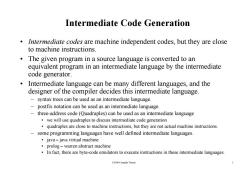
Intermediate Code Generation Intermediate codes are machine independent codes,but they are close to machine instructions. ● The given program in a source language is converted to an equivalent program in an intermediate language by the intermediate code generator. Intermediate language can be many different languages,and the designer of the compiler decides this intermediate language. syntax trees can be used as an intermediate language 一 postfix notation can be used as an intermediate language. three-address code (Quadraples)can be used as an intermediate language we will use quadraples to discuss intermediate code generation quadraples are close to machine instructions,but they are not actual machine instructions. some programming languages have well defined intermediate languages java-java virtual machine prolog-warren abstract machine In fact,there are byte-code emulators to execute instructions in these intermediate languages CS308 Compiler Theory 2
Intermediate Code Generation • Intermediate codes are machine independent codes, but they are close to machine instr ctions to machine instructions. • The given program in a source language is converted to an equivalent program in an intermediate language by the intermediate equivalent program in an intermediate language by the intermediate code generator. • Intermediate language can be many different languages, and the designer of the compiler decides this intermediate language. – syntax trees can be used as an intermediate language. – p gg ostfix notation can be used as an intermediate lan gua ge. – three-address code (Quadraples) can be used as an intermediate language • we will use quadraples to discuss intermediate code generation • qp , y uadra ples are close to machine instructions, but the y are not actual machine instructions. – some programming languages have well defined intermediate languages. • java – java virtual machine • prolog – warren abstract machine CS308 Compiler Theory 2 • In fact, there are byte-code emulators to execute instructions in these intermediate languages
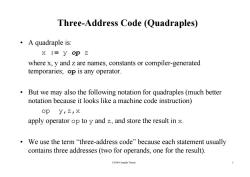
Three-Address Code (Quadraples) 。A quadraple is: x :y op z where x,y and z are names,constants or compiler-generated temporaries;op is any operator. But we may also the following notation for quadraples(much better notation because it looks like a machine code instruction) op yizIx apply operator op to y and z,and store the result in x. ·We use the term“three-address code”because each statement usually contains three addresses(two for operands,one for the result). CS308 Compiler Theory 3
Three-Address Code (Quadraples) • A quadraple is: x := y op z where x, y and z are names, constants or compiler-generated temporaries; op is any operator. • But we may also the following notation for quadraples (much better notation because it looks like a machine code instruction) op y,z,x apply operator op to y and z, and store the result in x. • We use the term “three-address code” because each statement usually t i th dd (t f d f th lt) CS308 Compiler Theory 3 con t a ins three addresses (two for operan ds, one for the result)

Three-Address Statements Binary Operator: op y,z,result or result :=y op z where op is a binary arithmetic or logical operator.This binary operator is applied to y and z,and the result of the operation is stored in result. Ex: add a,b,c gt a,b,c addr a,b,c addi a,b,c Unary Operator: op y,,result or result :op y where op is a unary arithmetic or logical operator.This unary operator is applied to y, and the result of the operation is stored in result. Ex: uminus ar c not arc inttoreal a,,c CS308 Compiler Theory 4
Three-Address Statements Binary Operator: op y,z,result or result := y op z w here op i bi ith ti l i l t Thi bi t i li d t is a binary arithmetic or logica l opera tor. This binary opera tor is appli e d to y and z, and the result of the operation is stored in result. Ex: add a,b,c gt a,b,c addr a,b,c addi a b c addi a,b,c Unary Operator: op y,,result or result := op y where op is a unary arithmetic or logical operator. This unary operator is applied to y, and the result of the operation is stored in result. Ex: uminus a,,c uminus a,,c not a,,c inttoreal a,,c CS308 Compiler Theory 4
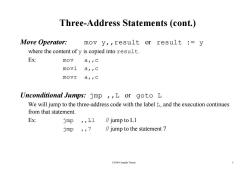
Three-Address Statements (cont.) Move Operator: mov y,,result or result :=y where the content of y is copied into result. Ex: mov arc movi arC movr ar c Unconditional Jumps:jmp ,,L or gotoL We will jump to the three-address code with the label L,and the execution continues from that statement. Ex: jmp ,L1 /∥jump to L1 jmp ,,7 /jump to the statement 7 CS308 Compiler Theory 5
Three-Address Statements (cont.) Move Operator: mov y,,result or result := y where the content of y is copied into result. Ex: mov a,,c movi a c movi a,, c movr a,,c Unconditional Jumps: jmp ,,L or goto L We will jump to the three-address code with the label L, and the execution continues from that statement. Ex: jmp ,,L1 // jump to L1 jmp 7 ,, 7 // jump to the statement 7 // jump to the statement 7 CS308 Compiler Theory 5
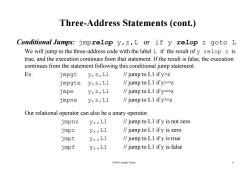
Three-Address Statements (cont.) Conditional Jumps:jmprelop y,z,L or if y relop z goto L We will jump to the three-address code with the label L if the result ofy relop z is true,and the execution continues from that statement.If the result is false,the execution continues from the statement following this conditional jump statement. Ex: jmpgt y,Z,L1 //jump to Ll if y>z jmpgte y,Z,L1 /jump to Ll ify>=z jmpe y,z,L1 /jump to Ll ify=-z jmpne y,Z,L1 /jump to Ll if y!=z Our relational operator can also be a unary operator. jmpnz Y,,L1 /jump to Ll ify is not zero jmpz y,,L1 /jump to Ll ify is zero jmpt y,,L1 /jump to Ll ify is true jmpf y,,L1 /jump to Ll ify is false CS308 Compiler Theory 6
Three-Address Statements (cont.) Conditional Jumps: jmprelop y,z,L or if y relop z goto L We will jump to the three-address code with the label L if the result of y relop z is true, and the execution continues from that statement. If the result is false, the execution continues from the statement followin g jp this conditional jum p statement. Ex: jmpgt y,z,L1 // jump to L1 if y>z jmpgte y,z,L1 // jump to L1 if y>=z jmpe y,z,L1 // jump to L1 if y==z jmpne y,z,L1 // jump to L1 if y!=z Our relational operator can also be a unary operator. jmpnz y,,L1 // jump to L1 if y is not zero j L1 mpz y,,L1 // j t L1 if i // jump to L1 if y is zero jmpt y,,L1 // jump to L1 if y is true jmpf y,,L1 // jump to L1 if y is false CS308 Compiler Theory 6 jmpf y,,L1 // jump to L1 if y is false
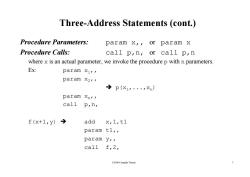
Three-Address Statements (cont.) Procedure Parameters: param x,,or param x Procedure Calls: call p,n,or call p,n where x is an actual parameter,we invoke the procedure p with n parameters. Ex: param x param ¥21I →p(x1,·.·,xm) param XnlI call pin, f(x+1,y)→ add x,1,t1 param t1,, param y, call f,2, CS308 Compiler Theory 7
Three-Address Statements (cont.) Procedure Parameters: param x,, or param x Procedure Calls: call p,n, or call p,n where x is an actual parameter, we invoke the procedure p with n parameters. Ex: param x 1,, param x 2,, Î p(x 1,...,x n) param x n,, call p,n, f(x+1,y) Î add x,1,t1 param t1,, param y,, call f,2, CS308 Compiler Theory 7 call f,2

Three-Address Statements (cont.) Indexed Assignments: move y[i],x or x :=y[i] move x,,y[i] or y[i]:x Address and Pointer Assignments: moveaddr y,x or X:= &y movecont y,,x or x :*y CS308 Compiler Theory 8
Three-Address Statements (cont.) Indexed Assignments: move y[i],,x or x := y[i] move x,,y[i] or y[i] := x Address and Pointer Assignments: moveaddr y,,x or x := &y movecont y,,x or x := *y CS308 Compiler Theory 8

Syntax-Directed Translation into Three-Address Code S→id:=E S.code=E.code ll gen('mov'E.placeid.place) E→E1+E2 E.place newtemp(); E.code=Ei.code‖E2.code‖gen(add'E1.place‘,'E,place‘,'E.place) E→E1*E2 E.place newtemp(); E.code=Ecodel E2.codell gen(mult'Eplace,E2-place,E.place) E→-E1 E.place newtemp(); E.code=E1.code ll gen('uminus'E1.place,'E.place) E→(E1) E.place=E1.place; E.code=E.code E→id E.place=id.place; E.code null CS308 Compiler Theory
Syntax-Directed Translation into Three-Address Code S → id := E S.code = E.code || gen(‘mov’ E.place ‘,,’ id.place) E → E E E l () 1 + E 2 E.p lace = newtemp(); E.code = E1.code || E 2.code || gen(‘add’ E1.place ‘,’ E 2.place ‘,’ E.place) E → E1 * E 2 E place = newtemp(); 1 E 2 E.place newtemp(); E.code = E1.code || E 2.code || gen(‘mult’ E1.place ‘,’ E 2.place ‘,’ E.place) E → - E1 E.place = newtemp(); E.code = E1.code || gen(‘uminus’ E1.place ‘,,’ E.place) E → ( E1 ) E.place = E1.place; Ed E .co de = E1.co d e E → id E.place = id.place; E code . = null CS308 Compiler Theory 9
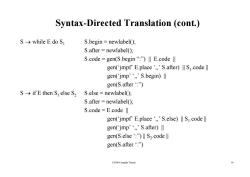
Syntax-Directed Translation (cont.) S-→while E do S, S.begin newlabelO); S.after newlabelO; S.code=gen(S.begin“:")‖E.code ll gen(‘jmpf E.place‘,'S.after)‖S1.code‖ gen(jmp',,'S.begin)ll gen(S.after :" S->if E then S else S2 S.else=newlabel(); S.after newlabel(); S.code=E.code‖ gen(jmpf E.place'S.else)ll S1.codell gen(jmp'‘,'S.after)‖ gen(S.else")Il S2.codell gen(S.after :" CS308 Compiler Theory 10
Syntax-Directed Translation (cont.) S → while E do S1 S.begin = newlabel(); S f l b l() S.a fter = new l a b el(); S.code = gen(S.begin “:”) || E.code || gen(‘jmpf’ E place ‘ ’ S after) || S1 gen( jmpf E.place ,, S.after) || S code || 1.code || gen(‘jmp’ ‘,,’ S.begin) || gen(S.after ‘:”) S → if E then S1 else S 2 S.else = newlabel(); S.after = newlabel(); S d E d || S.co de = E.co de || gen(‘jmpf’ E.place ‘,,’ S.else) || S1.code || gen( jmp ‘ ’ ‘,,’ S after) || S.after) || gen(S.else ‘:”) || S 2.code || gen(S.after ‘:”) CS308 Compiler Theory 10
按次数下载不扣除下载券;
注册用户24小时内重复下载只扣除一次;
顺序:VIP每日次数-->可用次数-->下载券;
- 上海交通大学:《编译原理》教学资源_教学资料_第八周讲义_Machine-Independent Optimizations Ⅲ.pdf
- 上海交通大学:《编译原理》教学资源_教学资料_第八周讲义_Machine-Independent Optimizations Ⅱ.pdf
- 上海交通大学:《编译原理》教学资源_教学资料_第八周讲义_Machine-Independent Optimizations Ⅰ.pdf
- 上海交通大学:《编译原理》教学资源_教学资料_第五周讲义_Type Checking.pdf
- 上海交通大学:《编译原理》教学资源_教学资料_第二周讲义_lex.pdf
- 上海交通大学:《编译原理》教学资源_教学资料_第二周讲义_Syntax Analyzer.pdf
- 上海交通大学:《编译原理》教学资源_教学资料_第二周讲义_Lexical Analyzer.pdf
- 上海交通大学:《编译原理》教学资源_教学资料_第九周讲义_Machine-Independent Optimizations Ⅳ.pdf
- 上海交通大学:《编译原理》教学资源_教学资料_第九周讲义_CS308 Compiler Theor.pdf
- 上海交通大学:《编译原理》教学资源_教学资料_第九周讲义_CS308 Compiler Theor.pdf
- 上海交通大学:《编译原理》教学资源_教学资料_第三周讲义_Bottom-Up Parsing.pdf
- 上海交通大学:《编译原理》教学资源_教学资料_第三周讲义_Top-Down Parsing.pdf
- 上海交通大学:《编译原理》教学资源_教学资料_第七周讲义_Code Generation Ⅱ.pdf
- 上海交通大学:《编译原理》教学资源_教学资料_第一周讲义_A Simple Syntax-Directed Translator.pdf
- 上海交通大学:《编译原理》教学资源_教学资料_第一周讲义_Introduction to Compilin.pdf
- 上海交通大学:《编译原理》教学资源_教学资料_第一周讲义_Parameter Passing Mechanisms.pdf
- 上海交通大学:《编译原理》教学资源_教学资料_第一周讲义_CS308 Compiler Theory.pdf
- 上海交通大学:《程序设计思想与方法》课程教学资源(PPT课件讲稿)CT15 并发与多线程.ppt
- 上海交通大学:《程序设计思想与方法》课程教学资源(PPT课件讲稿)CT14 Python GUI工具包:Tkinter.ppt
- 上海交通大学:《程序设计思想与方法》课程教学资源(PPT课件讲稿)CT13 算法设计分析.ppt
- 上海交通大学:《编译原理》教学资源_教学资料_第六周讲义_Heap Management.pdf
- 上海交通大学:《编译原理》教学资源_教学资料_第六周讲义_Run-Time Environments.pdf
- 上海交通大学:《编译原理》教学资源_教学资料_第四周讲义_Syntax-Directed Translation.pdf
- 上海交通大学:《计算机辅助设计》教学资源_Product Visualization.doc
- 上海交通大学:《科学计算》课程教学资源(英文讲义)Lecture Note 1:Introduction, calculus review and computer representation of numbers.pdf
- 上海交通大学:《科学计算》课程教学资源(英文讲义)Lecture Note 2:Solution of nonlinear equations.pdf
- 上海交通大学:《科学计算》课程教学资源(英文讲义)Lecture Note 3:Polynomial Interpolation.pdf
- 上海交通大学:《科学计算》课程教学资源(英文讲义)Lecture Note 4:Numerical differentiation and integration.pdf
- 上海交通大学:《程序设计思想与方法》课程教学资源(上机课)第一次上机_第一次上机内容_10.18.doc
- 上海交通大学:《程序设计思想与方法》课程教学资源(上机课)第一次上机_第一次上机内容_10.18.pdf
- 上海交通大学:《程序设计思想与方法》课程教学资源(上机课)第三次上机_python第三次上机.doc
- 上海交通大学:《程序设计思想与方法》课程教学资源(上机课)第三次上机_Python第三次上机解析-update.doc
- 上海交通大学:《程序设计思想与方法》课程教学资源(上机课)第五次上机_第五次上机.doc
- 上海交通大学:《程序设计思想与方法》课程教学资源(上机课)第四次上机_Python第四次上机题目.doc
- 上海交通大学:《程序设计思想与方法》课程教学资源_作业_第一次作业内容要求.doc
- 上海交通大学:《程序设计思想与方法》课程教学资源_作业_第一次作业内容要求.pdf
- 上海交通大学:《程序设计思想与方法》课程教学资源_参考教材_HowToThink-Python.pdf
- 上海交通大学:《程序设计思想与方法》课程教学资源_参考教材_参考教材-2002版-PythonProgrammingBook.pdf
- 上海交通大学:《程序设计思想与方法》课程教学资源_参考教材_参考教材-python-programming.pdf
- 上海交通大学:《程序设计思想与方法》课程教学资源_往年试卷_CT2012-A卷-final 2_参考答案.doc
